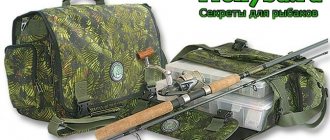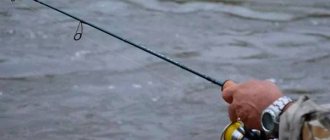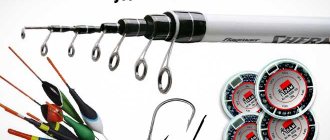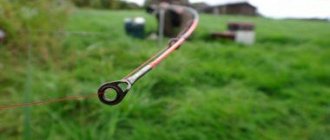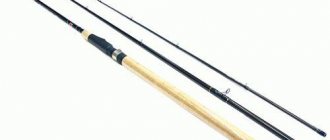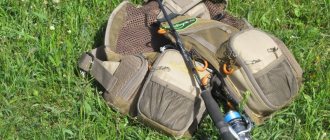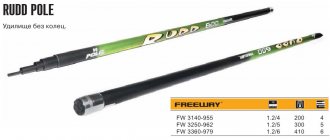For those who have never used this fishing method, fly rod may seem strange. An unnaturally short handle and a reel located below the handle can only cause bewilderment for a fisherman accustomed to traditional gear. That is why fly fishing is considered a separate method of fishing. And the fly fishing tackle is unique.
Fly fishing
Many fish (trout, taimen, grayling, chub and others) get their food from the surface of the reservoir or in the near-surface layer. Casting and keeping bait on the surface with traditional gear is quite a difficult task.
This bait is too light for ordinary tackle. Even a weak breeze easily blows it away at the moment of casting. Fish in the near-surface layer see well and at the same time stand against the current in the river. The bait has to be supplied in such a way that it is carried by the current to the fish sites, while the fisherman remains unnoticed. Difficult task. It is incredibly difficult to achieve this with ordinary tackle, even with a fair wind.
Therefore, the trendsetters of fishing fashion, the British, came up with a fishing method in which the bait is fed to the required distance not due to the weight of the bait, but due to the properties of the elastic cord used in the equipment instead of fishing line. The experience of the British was used by the Americans, who are currently leaders in this method of fishing and most of the new products associated with fly fishing appear in Europe from America.
This method of fishing is called fly fishing. It is widely used in fishing on cold, fast-moving rivers, usually with a rocky bottom and shallow depth. In addition, fly fishing has taken root in fishing (for the same trout) in lakes, mangrove forests, coral reefs, and in the tropical forests of Asia, Africa and America.
Of course, modern fly fishing as a fishing method is seriously different from the one with which the British began. Much has changed in fisherman's equipment since those times, but the basic elements have remained the same.
DIY fly fishing reel
Make your own fly fishing reel
A fly reel is practically not involved in the process of fishing and plays more of an auxiliary role, placing a cord and backing on the reel (an extension cord or an ordinary monofilament line) and takes part only when landing large fish. But this in no way diminishes its significant role in fly fishing gear. It is essentially the only element that can serve you for many, many years. That is why it is advisable to immediately purchase a good, comfortable, reliable reel with a friction brake.
But, as often happens, our capabilities do not always coincide with our desires and therefore we can save on the reel (in case of financial difficulties). And also in a situation where the nearest store with fly fishing accessories is very, very far away, you can try to make a reel yourself. In the early 2000s I had just such a situation. And I will briefly describe this process.
The design of a fly fishing reel differs from a conventional inertial one primarily in the presence of two or three protrusions of the reel body to the outer edge of the drum to prevent the line from tangling over the reel stand. At that time, I didn’t have to hold a real branded reel in my hands and I developed the design of the reel myself, using a small “Neva” inertial reel as a basis. This is what the final version already looks like (on the left is the first, more successful option).
The strut, axle, hub and spokes of the drum, as well as the ratchet brake mechanism, were taken from the “Neva”. The body and rear wall were turned from the piston separately by a familiar turner, the cheeks of the drum were cut out and turned from durable duralumin. Assembled and adjusted by hand.
Currently, after 10 years of oblivion, the reel looks a little scary, but it is still in working order and you can even go fishing with it now. The second version of the homemade coil (it’s in the second photo on the right) also required significant effort in manufacturing. The main spare parts are taken from a large “Neva”, inertial, spinning reel. The stainless steel body is made by pressing. For both reels, the drums can be removed with a slight movement. They have good movement and relatively small gaps.
In terms of design, this reel is closer to the branded one, in which (unlike my homemade products) everything is made as convenient, beautiful and functional as possible, including an adjustable friction brake.
The conclusions from everything written are simple - if possible, purchase factory-made coils, especially since the lower price threshold is only about 500 rubles. Although (if possible) making a good reel will also not be difficult (much better than mine - because I initially made them as a temporary option, without putting my soul into the process...)
On topic: Do-it-yourself fly fishing leader
DIY fly fishing rod
DIY fly fishing cord
Material
This is a special type of fishing rod. Such fishing rods are made from the following materials:
- Fiberglass;
- Carbon fiber materials (modified carbon);
- Glued bamboo.
Fishing rods made of fiberglass are durable, flexible and quite affordable in price. This material has one significant drawback - its own weight. Fiberglass rods are heavy. A fisherman who has to almost constantly re-throw his tackle gets tired very quickly. Therefore, these days such rods are used mainly in sea fishing, in cases where power and reliability are required from the rod.
Carbon fiber rods are flexible and durable. They cost more than fiberglass rods. But they weigh much lighter. A fisherman can make many more casts without the slightest sign of fatigue. The disadvantages of this material are:
- high electrical conductivity (carbon fiber fishing rods are dangerous to use during thunderstorms and to fish under power lines);
- the need for constant preventative maintenance of the rod after fishing.
But these shortcomings more than pay off when fishing. Currently, most manufacturers produce fly fishing rods from carbon fiber.
Glued bamboo is an elite material. A wealthy professional fly fisherman can be identified by his fishing rod.
The very first fly fishing rods were made from laminated bamboo. These fishing rods are made by hand. During the production process, only high-quality varieties of bamboo are used, which are selected and polished exclusively by hand. This rod is quite expensive. And until now, bamboo rods are considered the elite fishing rods for this method of fishing, although they are difficult to operate and maintain.
Fly Reel Options
They produce three types of fly fishing reels: direct or reverse, automatic and multiplier. Each model has a lot of fans and opponents. However, for inexperienced anglers it is better to start with a regular one. What is the difference between the other two coils:
- multiplier acquired its name due to the fact that when the handle is turned, the drum makes a greater number of them;
- The machines are designed in such a way that the cord comes out after pressing the lever; they are used for light classes.
A decent reel has a high-quality adjustment of the braking system for retrieving fish and a design that prevents the line from overrunning when casting the tackle. In addition, the spool must contain at least fifty meters of backing and a cord equipped with a leader and a leash.
The reel can also be marine. Its distinctive characteristics are wear-resistant and durable material, which is not afraid of corrosion, and a powerful braking system. Such devices for the sea are produced no lower than the seventh class, since fishing is carried out with large flies.
Before you start equipping the reel with a cord, you need to decide which hand will be used to reel in the reel. Many fishermen reel in their rigs with their left hand, which is why reels have a left-handed handle. However, it will not be difficult to remake it to the other side. It is enough to disassemble the mechanism and rearrange the brake system.
So, you have a rod, reel and other equipment available. Assembly begins with winding the backing, which we wrote about in the article “Fly fishing: how to use a reel and avoid many problems.” It must be laid at least forty meters. It is required when fishing for fighting fish, characterized by sharp jerks, and at the same time serves as the basis for the line.
Features of fly fishing rods
Fly fishing rods are always composite. They consist of two or four knees. The method of connecting them is plug-in. There are two types of such connections:
- The upper elbow is inserted into the lower one;
- The lower elbow is inserted into the upper one;
Which one should you prefer? A non-professional will not notice much of a difference. Matter of habit.
The fly fishing rod equipment includes:
- pass rings;
- reel seat;
- handle;
Passage rings (from 5 to 11 pieces) are always made of metal. For sea fishing, this metal undergoes additional anti-corrosion treatment in the factory. A fly fishing rod can be equipped with different types of guides, from the traditional “snake” to regular rings (on one leg) with or without liners.
The reel seat is located almost on the butt of the rod. This type of placement is necessary for better balance of the rod. This is the main difference between a fly fishing rod and all other rods. For novice fishermen, the type of reel mount does not matter much.
The handle of this type of fishing rod is short, made of different materials, the main property of which is a low slip coefficient.
Rod classes
All fly fishing rods are divided into classes:
- rods of classes 0 – 2 are short (length from 1.8 to 2.1 meters) and very light. They are designed for catching small trout and chub on small rivers. In combination with these rods, the smallest and lightest baits are used (dry, wet and slightly loaded nymphs and flies). The characteristics of such rods do not allow long casts.
- Rods of classes 3 – 4 with a length of 2.1 to 2.7 meters are also quite light. Due to the length of the rod, it is possible to cast bait at distances of over 10 meters. Dry and wet flies, as well as loaded nymphs, can be used as bait.
Rods of classes 0 to 4 are recommended for beginner fly fishers. With their help, you can learn how to cast bait, how to retrieve it and control it.
- Rods of 5-6 classes are the most popular fishing rods for those who already have basic skills in working with heavier baits. Rods of these classes have a length of 2.6 - 2.8 m, they allow you to serve medium-sized bait (all types of flies, loaded nymphs and streamers up to 6 cm long) at a distance of up to 20 m. With such a fishing rod you can go out to medium-width rivers and fish fish weighing more than 2 kg.
- Rods of 7-9 classes are used for catching large fish (like taimen and salmon) in fairly wide bodies of water. The length of such a fishing rod can reach 4.5 meters. The rigging of such a rod usually uses heavy baits (heavy flies and streamers). Casting can be done at a distance of up to 30 meters. Sometimes such rods are used in catching sea predators.
- Rods of 10 – 12 classes are used only in sea fishing. They are characterized by long range, increased strength and flexibility.
indicator of fly fishing rods is considered decisive in the selection of a suitable fishing rod.
Characteristics of rods
By material
- Made from fiberglass. Gradually falling out of use. This is due to its heaviness, unnecessary vibrations when casting and not very high quality. Such rods are inexpensive, and there are companies that still produce them for fishing at a short distance from the shore.
- Made from carbon fiber. The most common material for fishing rods today. Its main advantage is its lightness, because when fly fishing, the main physical load falls on the hands. Such gear is more expensive than their fiberglass counterparts, and this is the case when the quality justifies the price: the higher it is, the better the rod corrects mistakes made when casting.
- Made from laminated bamboo. These fishing rods are made by hand, so they are the most expensive in this segment. They require special care: moisture ingress makes them vulnerable.
- Made of wood. Today this natural material is no longer used for the production of fishing rods; they can only be purchased from collectors. Such fishing equipment has great power and significant weight.
By class
There are 21 of them in total: the division depends on the weight of the cord, which can change at the moment of throwing. Only the first nine meters of cord are counted. The lightest class is 000, the heaviest is 18. The higher the class, the heavier the bait you can use and count on catching heavier fish. If you plan to catch small fish in good weather, rods of 0-3 classes are suitable. To catch medium-sized specimens in lakes or on currents, it is better to use gear belonging to classes 4-6. Predatory fish should be caught using equipment of 7-9 classes. Rods from class 10 and above are intended for sea “hunting” for large fish.
By weight
This parameter is directly related to the class of the rod: the lower it is, the lighter the tackle will be.
By formation
The indicator is of fundamental importance: it indicates the ability of the rod to impart a certain amount of energy to the cord. The faster the action, the greater the speed the line can develop when casting.
- Fast (hard). Only the tip bends. This equipment is suitable for long-distance casting. High line speed is guaranteed, but this requires an experienced hand. Optimal for fishing with heavy bait.
- Medium-fast (upper parabolic). The upper third of the equipment bends. It is possible to use it at medium and long distances using weighted baits.
- Medium (parabolic). The most versatile system, very popular among anglers. The bend of the equipment resembles a parabola.
- Slow (soft). Such equipment bends almost completely along its entire length.
The figure shows a table of rod curvature options. Its decoding shows how part of the rod bends with each specific action.
By lenght
In the classic version, this figure varies from 2.4 to 2.7 m. You can find shorter or longer gear on sale. For example, a rod shorter than 2.4 m is used when fishing from a boat.
By connection type
There are three of them:
- using a carbon fiber pin glued into the lower elbow;
- the upper knee enters the lower one;
- the lower knee is placed in the upper one.
According to the shape of the handle
- full profile (there are extensions at both ends);
- semi-profile (they have an extension only at one end);
- cigar-shaped.
Video tips for choosing a fishing rod:

